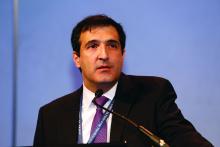User login
It’s relatively safe to surgically treat anomalous aortic origin of a coronary artery in children and adolescents, with essentially all patients cleared for full activity after 3 months, according to a study presented by Carlos M. Mery, MD.
Anomalous aortic origin of a coronary artery (AAOCA) is the second leading cause of sudden cardiac death (SCD) in young people, noted Dr. Mery of Texas Children’s Hospital at the plenary session of the 2017 AATS Centennial meeting.
Surgical indications included an anomalous left coronary artery, ischemic symptoms, a positive nuclear perfusion test (NPT), or high-risk anatomy such as long intramural segment or ostial stenosis identified via CT angiography. Median patient age was 14 years.
Nine of the patients (20%) underwent surgery for an anomalous left coronary artery, with 32 patients (80%) receiving surgical intervention for an anomalous right coronary artery.
A total of 34 surgical procedures (77%) were unroofing of intramural segments, 7 were coronary translocations (16%), and 2 were ostioplasties (4%).
There were no operative deaths. One patient required coronary artery bypass grafting after developing ischemia following a coronary translocation. Minor complications were seen in eight other patients (18%).
One patient presented with a second episode of aborted sudden cardiac death 1 year after unroofing of an anomalous left coronary artery with a short intramural segment, and underwent successful coronary translocation and unroofing of a previously identified myocardial bridge.
At follow-up (median 2 years), 40 patients were asymptomatic (91%), while 4 patients had nonspecific chest pain (9%). Forty-one patients (93%) had returned to full activity, while 3 patients were waiting for their 3-month clearance to return to full activity. ■
[email protected]
It’s relatively safe to surgically treat anomalous aortic origin of a coronary artery in children and adolescents, with essentially all patients cleared for full activity after 3 months, according to a study presented by Carlos M. Mery, MD.
Anomalous aortic origin of a coronary artery (AAOCA) is the second leading cause of sudden cardiac death (SCD) in young people, noted Dr. Mery of Texas Children’s Hospital at the plenary session of the 2017 AATS Centennial meeting.
Surgical indications included an anomalous left coronary artery, ischemic symptoms, a positive nuclear perfusion test (NPT), or high-risk anatomy such as long intramural segment or ostial stenosis identified via CT angiography. Median patient age was 14 years.
Nine of the patients (20%) underwent surgery for an anomalous left coronary artery, with 32 patients (80%) receiving surgical intervention for an anomalous right coronary artery.
A total of 34 surgical procedures (77%) were unroofing of intramural segments, 7 were coronary translocations (16%), and 2 were ostioplasties (4%).
There were no operative deaths. One patient required coronary artery bypass grafting after developing ischemia following a coronary translocation. Minor complications were seen in eight other patients (18%).
One patient presented with a second episode of aborted sudden cardiac death 1 year after unroofing of an anomalous left coronary artery with a short intramural segment, and underwent successful coronary translocation and unroofing of a previously identified myocardial bridge.
At follow-up (median 2 years), 40 patients were asymptomatic (91%), while 4 patients had nonspecific chest pain (9%). Forty-one patients (93%) had returned to full activity, while 3 patients were waiting for their 3-month clearance to return to full activity. ■
[email protected]
It’s relatively safe to surgically treat anomalous aortic origin of a coronary artery in children and adolescents, with essentially all patients cleared for full activity after 3 months, according to a study presented by Carlos M. Mery, MD.
Anomalous aortic origin of a coronary artery (AAOCA) is the second leading cause of sudden cardiac death (SCD) in young people, noted Dr. Mery of Texas Children’s Hospital at the plenary session of the 2017 AATS Centennial meeting.
Surgical indications included an anomalous left coronary artery, ischemic symptoms, a positive nuclear perfusion test (NPT), or high-risk anatomy such as long intramural segment or ostial stenosis identified via CT angiography. Median patient age was 14 years.
Nine of the patients (20%) underwent surgery for an anomalous left coronary artery, with 32 patients (80%) receiving surgical intervention for an anomalous right coronary artery.
A total of 34 surgical procedures (77%) were unroofing of intramural segments, 7 were coronary translocations (16%), and 2 were ostioplasties (4%).
There were no operative deaths. One patient required coronary artery bypass grafting after developing ischemia following a coronary translocation. Minor complications were seen in eight other patients (18%).
One patient presented with a second episode of aborted sudden cardiac death 1 year after unroofing of an anomalous left coronary artery with a short intramural segment, and underwent successful coronary translocation and unroofing of a previously identified myocardial bridge.
At follow-up (median 2 years), 40 patients were asymptomatic (91%), while 4 patients had nonspecific chest pain (9%). Forty-one patients (93%) had returned to full activity, while 3 patients were waiting for their 3-month clearance to return to full activity. ■
[email protected]
